北京外国语大学:《运筹学 Operations Research》课程教学资源(课件讲稿)线性代数 Linear Programming(主讲:陈曦)
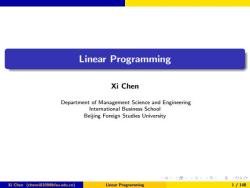
Linear Programming Xi Chen Department of Management Science and Engineering International Business School Beijing Foreign Studies University 4口40+4之4至,至)只0 Xi Chen (chenxi0109@bfsu.edu.cn) Linear Programming 1/148
Linear Programming Xi Chen Department of Management Science and Engineering International Business School Beijing Foreign Studies University Xi Chen (chenxi0109@bfsu.edu.cn) Linear Programming 1 / 148
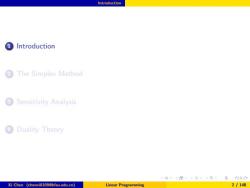
Introduction Introduction The Simplex Method Sensitivity Analysis Duality Theory 4口,40+4立4至,三)及0 Xi Chen (chenxi0109@bfsu.edu.cn) Linear Programming 2/148
Introduction 1 Introduction 2 The Simplex Method 3 Sensitivity Analysis 4 Duality Theory Xi Chen (chenxi0109@bfsu.edu.cn) Linear Programming 2 / 148
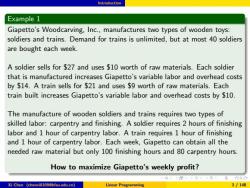
Introduction Example 1 Giapetto's Woodcarving,Inc.,manufactures two types of wooden toys: soldiers and trains.Demand for trains is unlimited,but at most 40 soldiers are bought each week. A soldier sells for $27 and uses $10 worth of raw materials.Each soldier that is manufactured increases Giapetto's variable labor and overhead costs by $14.A train sells for $21 and uses $9 worth of raw materials.Each train built increases Giapetto's variable labor and overhead costs by $10. The manufacture of wooden soldiers and trains requires two types of skilled labor:carpentry and finishing.A soldier requires 2 hours of finishing labor and 1 hour of carpentry labor.A train requires 1 hour of finishing and 1 hour of carpentry labor.Each week,Giapetto can obtain all the needed raw material but only 100 finishing hours and 80 carpentry hours. How to maximize Giapetto's weekly profit? Xi Chen (chenxi0109@bfsu.edu.cn) Linear Programming 3/148
Introduction Example 1 Giapetto’s Woodcarving, Inc., manufactures two types of wooden toys: soldiers and trains. Demand for trains is unlimited, but at most 40 soldiers are bought each week. A soldier sells for $27 and uses $10 worth of raw materials. Each soldier that is manufactured increases Giapetto’s variable labor and overhead costs by $14. A train sells for $21 and uses $9 worth of raw materials. Each train built increases Giapetto’s variable labor and overhead costs by $10. The manufacture of wooden soldiers and trains requires two types of skilled labor: carpentry and finishing. A soldier requires 2 hours of finishing labor and 1 hour of carpentry labor. A train requires 1 hour of finishing and 1 hour of carpentry labor. Each week, Giapetto can obtain all the needed raw material but only 100 finishing hours and 80 carpentry hours. How to maximize Giapetto’s weekly profit? Xi Chen (chenxi0109@bfsu.edu.cn) Linear Programming 3 / 148
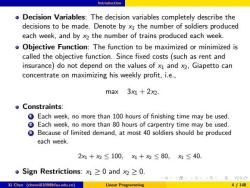
Introduction o Decision Variables:The decision variables completely describe the decisions to be made.Denote by x1 the number of soldiers produced each week,and by x2 the number of trains produced each week. oObjective Function:The function to be maximized or minimized is called the objective function.Since fixed costs (such as rent and insurance)do not depend on the values of x1 and x2,Giapetto can concentrate on maximizing his weekly profit,i.e.. max 3x1+2x2. ●Constraints: Each week,no more than 100 hours of finishing time may be used. Each week,no more than 80 hours of carpentry time may be used. Because of limited demand,at most 40 soldiers should be produced each week. 2x1+2≤100,为+9≤80,x1≤40. o Sign Restrictions:x≥0andx2≥0. Xi Chen (chenxi0109@bfsu.edu.cn) Linear Programming 4/148
Introduction Decision Variables: The decision variables completely describe the decisions to be made. Denote by x1 the number of soldiers produced each week, and by x2 the number of trains produced each week. Objective Function: The function to be maximized or minimized is called the objective function. Since fixed costs (such as rent and insurance) do not depend on the values of x1 and x2, Giapetto can concentrate on maximizing his weekly profit, i.e., max 3x1 + 2x2. Constraints: 1 Each week, no more than 100 hours of finishing time may be used. 2 Each week, no more than 80 hours of carpentry time may be used. 3 Because of limited demand, at most 40 soldiers should be produced each week. 2x1 + x2 ≤ 100, x1 + x2 ≤ 80, x1 ≤ 40. Sign Restrictions: x1 ≥ 0 and x2 ≥ 0. Xi Chen (chenxi0109@bfsu.edu.cn) Linear Programming 4 / 148
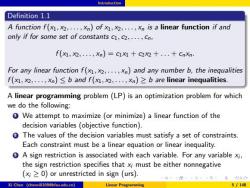
Introduction Definition 1.1 A function f(,x2,.·,xn)ofx为,x2,,xn is a linear function if and only if for some set of constants c1,c2,....cn. f (X1,X2,...,Xn)=c1x1 +c2x2+...+CnXn. For any linear function f(x1,x2,...,xn)and any number b,the inequalities f(xM,2,.,xn)≤b and f(灯,x2,.,xn)≥b are linear inequalities. A linear programming problem(LP)is an optimization problem for which we do the following: We attempt to maximize (or minimize)a linear function of the decision variables (objective function). The values of the decision variables must satisfy a set of constraints. Each constraint must be a linear equation or linear inequality. A sign restriction is associated with each variable.For any variable xi, the sign restriction specifies that xi must be either nonnegative (x;>0)or unrestricted in sign (urs). Xi Chen (chenxi0109@bfsu.edu.cn) Linear Programming 5/148
Introduction Definition 1.1 A function f (x1, x2, . . . , xn) of x1, x2, . . . , xn is a linear function if and only if for some set of constants c1, c2, . . . , cn, f (x1, x2, . . . , xn) = c1x1 + c2x2 + . . . + cnxn. For any linear function f (x1, x2, . . . , xn) and any number b, the inequalities f (x1, x2, . . . , xn) ≤ b and f (x1, x2, . . . , xn) ≥ b are linear inequalities. A linear programming problem (LP) is an optimization problem for which we do the following: 1 We attempt to maximize (or minimize) a linear function of the decision variables (objective function). 2 The values of the decision variables must satisfy a set of constraints. Each constraint must be a linear equation or linear inequality. 3 A sign restriction is associated with each variable. For any variable xi , the sign restriction specifies that xi must be either nonnegative (xi ≥ 0) or unrestricted in sign (urs). Xi Chen (chenxi0109@bfsu.edu.cn) Linear Programming 5 / 148
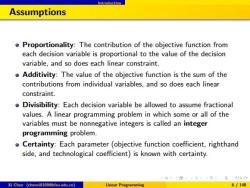
Introduction Assumptions oProportionality:The contribution of the objective function from each decision variable is proportional to the value of the decision variable,and so does each linear constraint. o Additivity:The value of the objective function is the sum of the contributions from individual variables,and so does each linear constraint. oDivisibility:Each decision variable be allowed to assume fractional values.A linear programming problem in which some or all of the variables must be nonnegative integers is called an integer programming problem. o Certainty:Each parameter(objective function coefficient,righthand side,and technological coefficient)is known with certainty. 0Q0 Xi Chen (chenxi0109@bfsu.edu.cn) Linear Programming 6/148
Introduction Assumptions Proportionality: The contribution of the objective function from each decision variable is proportional to the value of the decision variable, and so does each linear constraint. Additivity: The value of the objective function is the sum of the contributions from individual variables, and so does each linear constraint. Divisibility: Each decision variable be allowed to assume fractional values. A linear programming problem in which some or all of the variables must be nonnegative integers is called an integer programming problem. Certainty: Each parameter (objective function coefficient, righthand side, and technological coefficient) is known with certainty. Xi Chen (chenxi0109@bfsu.edu.cn) Linear Programming 6 / 148
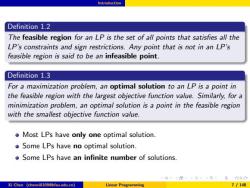
Introduction Definition 1.2 The feasible region for an LP is the set of all points that satisfies all the LP's constraints and sign restrictions.Any point that is not in an LP's feasible region is said to be an infeasible point. Definition 1.3 For a maximization problem,an optimal solution to an LP is a point in the feasible region with the largest objective function value.Similarly,for a minimization problem,an optimal solution is a point in the feasible region with the smallest objective function value. o Most LPs have only one optimal solution. Some LPs have no optimal solution. o Some LPs have an infinite number of solutions. Xi Chen (chenxi0109@bfsu.edu.cn) Linear Programming 7/148
Introduction Definition 1.2 The feasible region for an LP is the set of all points that satisfies all the LP’s constraints and sign restrictions. Any point that is not in an LP’s feasible region is said to be an infeasible point. Definition 1.3 For a maximization problem, an optimal solution to an LP is a point in the feasible region with the largest objective function value. Similarly, for a minimization problem, an optimal solution is a point in the feasible region with the smallest objective function value. Most LPs have only one optimal solution. Some LPs have no optimal solution. Some LPs have an infinite number of solutions. Xi Chen (chenxi0109@bfsu.edu.cn) Linear Programming 7 / 148
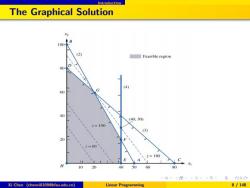
Introduction The Graphical Solution 100 B (2) Feasible region D 80 (4) 60 G 40 (40.30) z=100 (3) 60 2=180 E A C 10 20 40 50 60 80 Xi Chen (chenxi0109@bfsu.edu.cn) Linear Programming 8/148
Introduction The Graphical Solution Xi Chen (chenxi0109@bfsu.edu.cn) Linear Programming 8 / 148
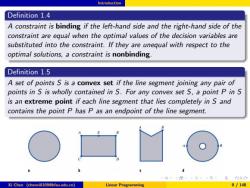
Introduction Definition 1.4 A constraint is binding if the left-hand side and the right-hand side of the constraint are equal when the optimal values of the decision variables are substituted into the constraint.If they are unequal with respect to the optimal solutions,a constraint is nonbinding. Definition 1.5 A set of points S is a convex set if the line segment joining any pair of points in S is wholly contained in S.For any convex set S,a point P in S is an extreme point if each line segment that lies completely in S and contains the point P has P as an endpoint of the line segment )Q0 Xi Chen (chenxi0109@bfsu.edu.cn) Linear Programming 9/148
Introduction Definition 1.4 A constraint is binding if the left-hand side and the right-hand side of the constraint are equal when the optimal values of the decision variables are substituted into the constraint. If they are unequal with respect to the optimal solutions, a constraint is nonbinding. Definition 1.5 A set of points S is a convex set if the line segment joining any pair of points in S is wholly contained in S. For any convex set S, a point P in S is an extreme point if each line segment that lies completely in S and contains the point P has P as an endpoint of the line segment. Xi Chen (chenxi0109@bfsu.edu.cn) Linear Programming 9 / 148

Introduction Example 2 Dorian Auto manufactures luxury cars and trucks.The company believes that its most likely customers are high-income women and men.To reach these groups,Dorian Auto has embarked on an ambitious TV advertising campaign and has decided to purchase 1-minute commercial spots on two types of programs:comedy shows and football games. Each comedy commercial is seen by 7 million high-income women and 2 million high-income men.Each football commercial is seen by 2 million high-income women and 12 million high-income men.A 1-minute comedy ad costs $50,000,and a 1-minute football ad costs $100,000.Dorian would like the commercials to be seen by at least 28 million high-income women and 24 million high-income men. How Dorian Auto can meet its advertising requirements at minimum cost? 0Q0 Xi Chen (chenxi0109@bfsu.edu.cn) Linear Programming 10/148
Introduction Example 2 Dorian Auto manufactures luxury cars and trucks. The company believes that its most likely customers are high-income women and men. To reach these groups, Dorian Auto has embarked on an ambitious TV advertising campaign and has decided to purchase 1-minute commercial spots on two types of programs: comedy shows and football games. Each comedy commercial is seen by 7 million high-income women and 2 million high-income men. Each football commercial is seen by 2 million high-income women and 12 million high-income men. A 1-minute comedy ad costs $50, 000, and a 1-minute football ad costs $100, 000. Dorian would like the commercials to be seen by at least 28 million high-income women and 24 million high-income men. How Dorian Auto can meet its advertising requirements at minimum cost? Xi Chen (chenxi0109@bfsu.edu.cn) Linear Programming 10 / 148
按次数下载不扣除下载券;
注册用户24小时内重复下载只扣除一次;
顺序:VIP每日次数-->可用次数-->下载券;
- 《运筹学 Operations Research》课程教学资源(书籍教材)《运筹学:应用和算法》电子书(第四版)Operations Research, Applications and Algorithms - Wayne L. Winston,4th.pdf
- 华东理工大学:《概率论与数理统计》课程教学资源(PPT课件讲稿)第7章 统计假设检验和区间估计.ppt
- 华东理工大学:《概率论与数理统计》课程教学资源(PPT课件讲稿)第6章 数理统计学中的基本概念.ppt
- 华东理工大学:《概率论与数理统计》课程教学资源(PPT课件讲稿)第5章 极限定理初步.ppt
- 华东理工大学:《概率论与数理统计》课程教学资源(PPT课件讲稿)第4章 随机变量的数学特征.ppt
- 华东理工大学:《概率论与数理统计》课程教学资源(PPT课件讲稿)第3章 多维随机变量.ppt
- 华东理工大学:《概率论与数理统计》课程教学资源(PPT课件讲稿)第2章 一维随机变量.ppt
- 华东理工大学:《概率论与数理统计》课程教学资源(PPT课件讲稿)第1章 应用概率统计(事件与概率).ppt
- 华东理工大学:《概率论与数理统计》课程教学资源(各章习题,共七章,含解答)probability theory & mathematical statistics.docx
- 《概率论与数理统计 probability theory & mathematical statistics》课程教学资源(参考文献)水塔水流量问题的广义线性回归解法.pdf
- 《概率论与数理统计 probability theory & mathematical statistics》课程教学资源(参考文献)在概率统计教学中培养学生的建模思想和能力.pdf
- 《概率论与数理统计 probability theory & mathematical statistics》课程教学资源(参考文献)概率论教学中“独立性”概念的一点注释.pdf
- 华东理工大学:《概率论与数理统计》课程教学资源(学习指导书)第7章 假设检验和区间估计.doc
- 华东理工大学:《概率论与数理统计》课程教学资源(学习指导书)第6章 事件数理统计的基本概念与概率.doc
- 华东理工大学:《概率论与数理统计》课程教学资源(学习指导书)第5章 极限定理初步.doc
- 华东理工大学:《概率论与数理统计》课程教学资源(学习指导书)第4章 随机变量的数学特征.doc
- 华东理工大学:《概率论与数理统计》课程教学资源(学习指导书)第3章 多维随机变量.doc
- 华东理工大学:《概率论与数理统计》课程教学资源(学习指导书)第2章 一维随机变量.doc
- 华东理工大学:《概率论与数理统计》课程教学资源(学习指导书)第1章 事件与概率.doc
- 运城学院:《抽象代数 Abstract algebra》课程教学资源(数学与应用数学专业人才培养方案,2021版).pdf
- 北京外国语大学:《运筹学 Operations Research》课程教学资源(课件讲稿)整数规划 Integer Programming.pdf
- 北京外国语大学:《Matlab》课程教学资源(课件讲稿)MATLAB在经济与管理研究中的应用理论与实例 An Introduction with Applications in Economics and Management.pdf
- 运城学院:《微分几何 Differential Geometry》课程教学资源(教学大纲).pdf
- 山西师范大学:数学与应用数学专业课程教学大纲(合集).pdf
- 山西师范大学:信息与计算科学专业课程教学大纲(合集).pdf
- 华东理工学院:《线性代数》课程教学资源(教学大纲,适用专业:药物制剂,主讲:刘剑平).pdf
- 华东理工学院:《线性代数》课程教学资源(学习指导书)前言、第一章 矩阵.pdf
- 华东理工学院:《线性代数》课程教学资源(学习指导书)第二章 行列式.pdf
- 华东理工学院:《线性代数》课程教学资源(学习指导书)第三章 矩阵的秩和线性代数方程组.pdf
- 华东理工学院:《线性代数》课程教学资源(学习指导书)第四章 向量空间.pdf
- 华东理工学院:《线性代数》课程教学资源(学习指导书)第五章 特征问题与二次型.pdf
- 华东理工学院:《线性代数》课程教学资源(PPT课件讲稿)第一章 矩阵.ppt
- 华东理工学院:《线性代数》课程教学资源(PPT课件讲稿)第二章 行列式.ppt
- 华东理工学院:《线性代数》课程教学资源(PPT课件讲稿)第三章 矩阵的秩和线性代数方程组.ppt
- 华东理工学院:《线性代数》课程教学资源(PPT课件讲稿)第四章 向量空间.ppt
- 华东理工学院:《线性代数》课程教学资源(PPT课件讲稿)第五章 特征值问题与二次型.ppt
- 四川省普通高等学校“专升本”选拔《高等数学》考试大纲(理工类).pdf
- 安徽医科大学:《医药高等数学》课程教学大纲 Medical Advanced Mathematics(45学时).doc
- 《医药高等数学 Medical Advanced Mathematics》课程教学资源(实践指导)积分与应用的单元自测(单选题).pptx
- 《医药高等数学 Medical Advanced Mathematics》课程教学资源(实践指导)导数与微分的单元自测(单选题).pptx
